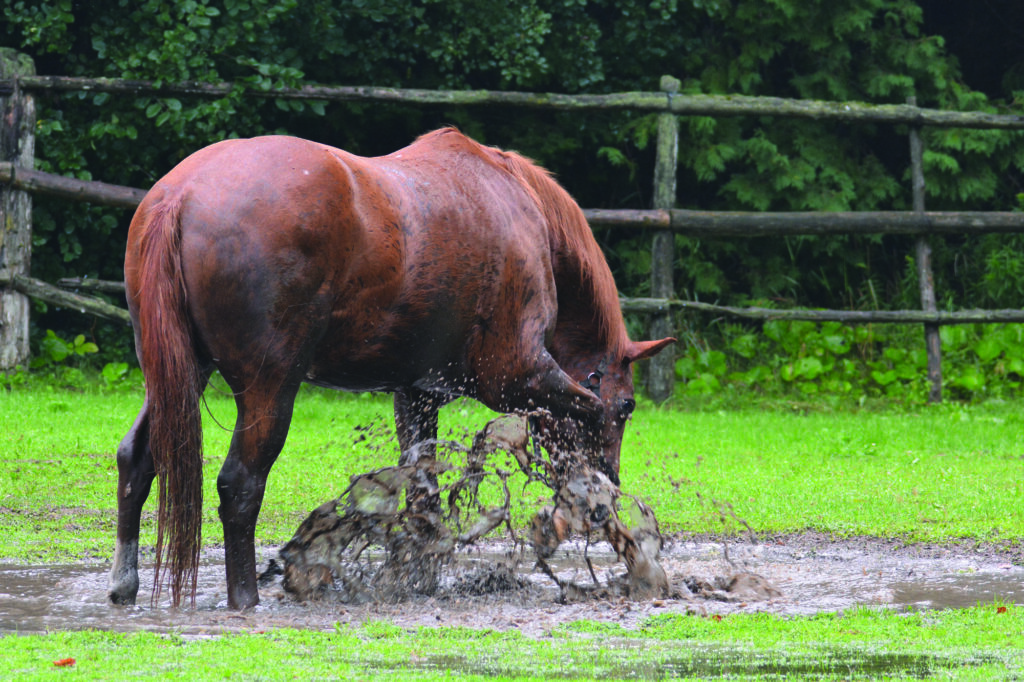Whether it is caused by torrential rain or a leaky water trough, mud is something that most horse owners will have to deal with at some point. A bit of mud every now and then generally won’t cause a problem, in fact it can actually be good. Some mud on the hooves can stop them from drying out and a roll in the mud can prevent insects from biting and stimulate oil production in the coat. But when it is prolonged exposure or not properly cleaned off that is when you can see problems develop.

The skin and hooves are the most common places we see problems caused by mud. Most conditions occur because mud provides ideal conditions for bacteria and fungus to thrive in and then infect the horse. Discussed below are some of the common conditions that are caused or exacerbated by mud.
Greasy Heel or Mud Fever
Greasy Heel, also known as Mud Fever, is a skin condition that affects the back of the pastern. It typically occurs during wet, humid or muddy conditions when the pastern area is constantly moist and unable to fully dry out. Symptoms include red inflamed skin, progressing to crusty oozing scabs. If left untreated secondary infections can occur and you can often see swelling moving up the leg.
Rain Scald
Rain Scald, sometimes referred to as Rain Rot, occurs after prolonged periods of the horse’s coat being wet, muddy or not being able to dry out properly. This then provides the ideal environment for bacteria to thrive. Rain scald develops when the bacteria enters through a break in the skin. The bacteria causes infection in the skin which then discharges a yellow-greenish pus. The pus causes matted hair and hair loss that tends to come out in tufts. The skin lesions can also become crusty, swollen, hot and are often sensitive or painful. It is typically seen in places where water or mud may sit or not drain easily like the back, rump, head, neck and wither.
White Line Disease / Seedy Toe
White line disease, also known as seedy toe, is a condition caused when bacteria and/or fungus enter the hoof through a crack, puncture or hole. It then causes separation of the hoof wall as the infection eats away the hoof and results in the hoof becoming white and crumbly. It can cause lameness but not always and sometimes brittle, dry hooves can be signs of white line disease. Mud not only provides the perfect environment for the bacteria but it then also blocks up the hole or crack in the hoof. This then means oxygen can not reach the bacteria allowing it to thrive and progress more.
Thrush
Thrush is caused by either a bacterial or fungal infection, or a combination of both. This infection causes a black gooey and bad smelling discharge usually found around the frog. If left untreated, thrush can cause frog and heel sensitivity developing into lameness. Thrush is most commonly found in horses that are kept in wet, dirty and muddy conditions as these are ideal conditions for the bacteria to thrive.
Abscesses and Bruises
Hoof/Sole Abscesses and Bruises are also more common with prolonged exposure to mud. The mud can soften both the sole and hoof making it easy for bruises or puncture wounds to occur. The bacteria from the mud can then easily enter through a puncture wound or trauma to the sole to cause an abscess. An abscess often results in sudden onset severe lameness, heat in the hoof, sometimes swelling in the lower leg and it will be painful when pressure is applied to the site of the infection.
Swamp Cancer
Swamp Cancer is a growth that develops on horses due to an aquatic fungal infection. They typically occur in horses that are found spending time in swamps, dams or mud in hot humid conditions where the fungus thrives. The fungus enters through a break in the skin, could be an insect bite, scratch or injury. The fungal infection takes hold causing an ulcerated swelling that often contains small gritty masses. The lesion can grow very large quickly and will not heal on its own, requiring veterinarian treatment for excision.
Prevention
The best thing you can do to prevent the above mentioned conditions is to keep your horse out of mud. Easier said than done! But if your horse is unable to be kept out of mud make sure that you are checking them daily for any open wounds that will allow bacteria or fungus to penetrate. Wash or brush the mud off as often as you can and keep your horse dry when possible.
For more information about Mud and Horses tune into the myPET Podcast. Dr Glenn and Aria discuss the common problems that horses face when it is muddy.
